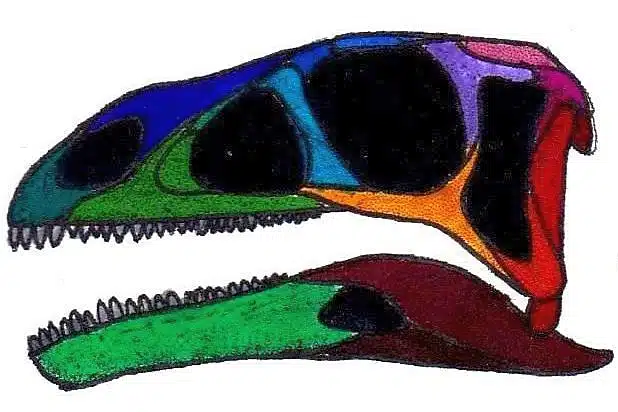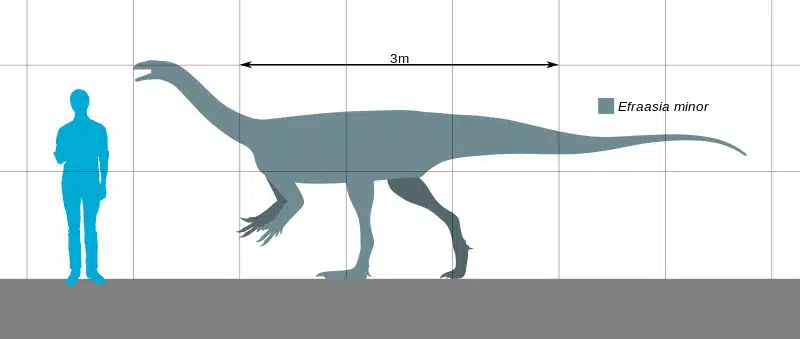The story of Efraasia, a modest yet fascinating creature from the Late Triassic Period, is a tale that spans over a century of discovery, debate, and diligent research. This basal sauropodomorph (or “prosauropod”), which roamed the lush landscapes of what is now Germany around 215.56 to 212.0 million years ago, offers invaluable insights into the early evolution of what would become the largest terrestrial animals of all time.
Efraasia’s taxonomic progression from fragmented remains to a coherent place within the sauropodomorph lineage provides an apt demonstration of the broader quest for knowledge that drives the scientific community. This narrative not only highlights the meticulous nature of paleontological work but also celebrates the dynamic, ever-evolving understanding of our planet’s ancient past.
Efraasia Key Facts
| Keyword | Fact |
|---|---|
| Pronunciation | E-FRAHS-ee-A |
| Meaning of name | Efraasia is named in honor of Eberhard Fraas a German scientist, geologist, and paleontologist. |
| Group | Sauropodomorpha |
| Type Species | Efraasia minor (syn. Teratosaurus minor, Thecodontosaurus) |
| Diet | Herbivore |
| When it Lived | 215.56 to 212.0 MYA |
| Period | Late Triassic |
| Epoch | Alaunian |
| Length | 21.0 feet |
| Height | Approximately 5.0 feet at hip |
| Weight | 660.0 to 1,320.0 pounds |
| Mobility | Primarily bipedal |
| First Discovery | 1902 by Eberhard Fraas |
| Described by | 1907 to 1908 by Friedrich von Huene |
| Holotype | SMNS 11838 |
| Location of first find | Württemberg, Germany |
Efraasia Origins, Taxonomy, and Timeline
The tale of Efraasia begins with its intriguing name, a tribute to Eberhard Fraas, a German scientist, geologist, and paleontologist, who worked as a curator at the Stuttgarter Naturaliensammlung. He is noted for discovering the dinosaurs of the Tendaguru Formation in what was then German East Africa (now Tanzania). This highlights his contributions to paleontology.

Efraasia occupies an interesting place within the sauropodomorph group, existing right on the cusp of the dramatic size increase that later sauropods would become famous for. Relatively modest in size, Efraasia still sported a body plan similar to its smaller bipedal ancestors, while showing the early hints of where this new (for saurischian dinosaurs) fully vegetarian diet was about to lead its lineage.
Existing about 215.56 to 212.0 million years ago during the Alaunian Epoch of the Middle Late Triassic Period, Efraasia it offers a glimpse into a world that was vastly different from our own.
Listen to Pronunciation
To get a sense of how to pronounce this ancient creature’s name correctly, feel free to check out this video.
Discovery & Fossil Evidence
The Initial Discovery

Ya-Ming Wang, Hai-Lu You & Tao Wang, CC BY 4.0, via Wikimedia Commons
The initial discovery and ultimate naming of Efraasia makes for fairly convoluted reading. In 1902 Albert Burrer, court stonemason at Maulbronn, began to exploit the Weiße Steinbruch, a quarry near Pfaffenhofen in Württemberg. Between 1906 and 1914 he donated the finds to paleontologist Professor Fraas of the Stuttgart Natural History Museum.
The Holotype and Beyond
Friedrich von Huene, a renowned name in the study of ancient life, was the first to describe the specimens that would later become Efraasia. The holotype, SMNS 11838, he named Teratosaurus minor, interpreting the remains as belonging to a theropod dinosaur. Later, in 1912, Eberhard Fraas referred two partial skeletons, SMNS 12667 and SMNS 12684, to the North American “prosauropod” Thecodontosaurus. Peter Galton later rebranded these specimens as Efraasia diagnostica while it ultimately fell to Adam Yates to recast the whole fossil trove (which had also gone by the appalations “Sellosaurus” and “Paleosaurus” by turns) as Efraasia minor in 2003.
The Legacy of Fossil Finds

While details about subsequent finds and the degree of fossil preservation vary, each discovery contributes to the broader narrative of Efraasia’s existence. These remnants from a bygone era provide invaluable insights into its physical form and lifestyle.
Efraasia Size and Description
Efraasia, a unique member of the sauropodomorph family, presents an intriguing blend of physical traits and adaptations that offer insights into the environments that early dinosaurs inhabited at the dawn of their reign.
Short Description of Efraasia
This prehistoric creature was once thought to be rather diminutive, due most of the referred fossils belonging to juvenile animals. However recent insights suggest otherwise. With a body that was lightly built for its size, Efraasia showcased a blend of both grace and strength. Its skeletal structure indicates a creature that was probably mostly bipedal but may have shifted to a quadrupedal gait in some contexts. However, the debate continues among researchers regarding its primary mode of locomotion, with some arguing for an obligate bipedal posture due to the limited pronation (turning the palm to face downwards) potential of the bones of its lower arm. Its long fingers and mobile thumbs were likely used for grasping food.
Size and Weight of Type Species

Efraasia, once its true adult size was understood, revealed itself to be a creature of reasonable size for its era. Efraasia’s juvenile specimens initially painted a picture of a small dinosaur, around 6.6 to 9.8 feet in length. However, as further material was understood to belong to this enigmatic taxon, paleontologists realized they had a much larger animal on their hands. An adult Efraasia is estimated to have reached about 21.0 feet in length, a substantial increase from earlier estimates. This re-evaluation of its size comes primarily from the analysis of specimen SMNS 12843, which boasts a femur length of approximately 24.7 inches. Such dimensions place Efraasia among the more sizable dinosaurs of its time, albeit with a build that leans towards the lighter side, considering its overall length.
Moreover, the unique derived traits, or autapomorphies, identified by Adam Yates helped differentiate Efraasia from similar dinosaurs, such as Plateosaurus, which occupied the same part of Europe at roughly the same time. These include a raised crescent-like ridge on the upper part of the inner side of the pubis shaft and a vaulted bony web between two lower extensions of a braincase bone. These features not only differentiate Efraasia from its contemporaries but also shed light on its evolutionary adaptations.
In conclusion, Efraasia’s size and physical characteristics paint a picture of a dynamic and adaptable dinosaur, capable of both bipedal and ( quadrupedal locomotion. Its structure, combining agility with a considerable size, marks it as a remarkable example of evolutionary ingenuity in the Late Triassic period.
The Dinosaur in Detail
Efraasia stands out for several unique features. Its evolutionary path on the stem leading to Sauropoda highlights the growing relationship between body size and the sheer amount of vegetation these animals would have been consuming daily. Notable specimens and fossil evidence continue to refine our comprehension of this intriguing dinosaur.
Its skull was small, pointed, and triangular, housing four teeth in the premaxilla. The neck of Efraasia, though moderately elongated, was slender, supporting a head that was likely quick to react and capable of precision movement. The tail, marked by low neural spines, and limbs, particularly the longer second finger compared to the third, add to the distinctive profile of this dinosaur. Furthermore, Efraasia’s feet, with a first toe that wasn’t strongly reduced, hint at a creature that was still relatively nimble on its feet compared to the latter behemoths of the Jurassic.
Contemporary Dinosaurs
Amidst the diverse fauna, Sellosaurus stood out, a contemporary of Efraasia, though larger in size. This dinosaur, with its distinctive posture and feeding habits, might have crossed paths with Efraasia in the quest for vegetation. The interactions between them, while not competitive, would have been a harmonious ballet of coexistence, a testament to the ecosystem’s capacity to sustain a variety of herbivorous giants.
Plateosaurus, another herbivore, shared the landscape with Efraasia. This larger and more robust contemporary could have frequented similar feeding grounds. Their presence together in the same ecosystem suggests a rich, abundant environment, where food sources were plentiful enough to support multiple large herbivores. The size difference between Efraasia and Plateosaurus might have influenced their feeding strategies, with Efraasia possibly navigating the lower foliage, while Plateosaurus reached higher.
In contrast, Liliensternus, a carnivore, added a different dynamic to the mix. Smaller than Efraasia, this agile predator might have viewed the larger Efraasia as a challenge or an opportunity. Their interactions, potentially predator and prey, would have been a dramatic display of the natural order in the Late Triassic, a constant dance between survival and predation.
Procompsognathus, another carnivorous contemporary, was smaller still. Its presence alongside Efraasia paints a picture of an ecosystem where size and diet varied widely. These smaller predators would have brought a different kind of tension to Efraasia’s world, possibly preying on smaller or younger members of its kind.
Finally, Ruehleia, a less-known contemporary, shared the Triassic world with Efraasia. The possible interactions between them remain a subject of speculation, adding an element of mystery to our understanding of this ancient world.
Interesting Points about Efraasia
- Efraasia’s name pays homage to Eberhard Fraas, connecting its legacy directly to its discoverer.
- Its existence during the Norian Strage of the Late Triassic marks it as a key figure in the early evolution of sauropodomorph dinosaurs.
- The location of its discovery in Württemberg, Germany underscores the geographical spread of dinosaurs during the Triassic Period, with similar dinosaurs known in the parts of Pangea now known as the Americas, Africa, China and even Antarctica.
- The ongoing study of Efraasia helps in understanding the broader ecological dynamics of its time.
Efraasia in its Natural Habitat
Triassic Life and Landscape
Efraasia lived during a time of profound geological and climatic change. The Late Triassic environment, particularly the Norian Stage, was marked by diverse ecosystems, ranging from dense forests to arid deserts.
Dietary Habits and Locomotion
As an herbivore, it thrived on the lush vegetation of its era. Its physical structure suggests it was mainly bipedal, although it may have come down on all fours in certain contexts, a versatility that would have been beneficial in foraging.
Ecosystem Role
Efraasia’s role in its habitat was significant. As a herbivore it shaped the landscape through its feeding habits. Moreover it also played a part in the ecosystem’s balance. Its feeding habits influencing plant growth and serving as a potential prey for predators of the time.
Frequently Asked Questions
Efraasia was an herbivore, feeding on the abundant vegetation of the Late Triassic Period.
Mainly on two legs, although it likely had the ability to move on both two or four legs. This gave it great versatility in locomotion.
Efraasia was discovered in Württemberg, Germany, shedding light on the dinosaur’s geographic range.
This dinosaur existed around 215.56 to 212.0 million years ago, during the Norian Stage of the Late Triassic.
Efraasia is named in honor of Eberhard Fraas a German scientist, geologist, and paleontologist.
An adult Efraasia is estimated to have reached about 21.0 feet in length.
Sources
The information in this article is based on various sources, drawing on scientific research, fossil evidence, and expert analysis. The aim is to provide a comprehensive and accurate overview of Efraasia. However, please be aware that our understanding of dinosaurs and their world is constantly evolving as new discoveries are made.
- https://onlinelibrary.wiley.com/doi/abs/10.1111/j.0031-0239.2003.00301.x
- https://www.researchgate.net/publication/226198702_On_the_anatomy_and_relationships_ofEfraasia_diagnosticaHuene_n_gen_a_prosauropod_dinosaur_Reptilia_Saurischia_from_the_Upper_Triassic_of_Germany
- https://www.researchgate.net/publication/272152579_An_early_prosauropod_dinosaur_from_the_Upper_Triassic_of_Nordwurttemberg_West_Germany
Article last fact checked: Joey Arboleda, 03-16-2024
Featured Image Credit: www.dinosaurpictures.org
